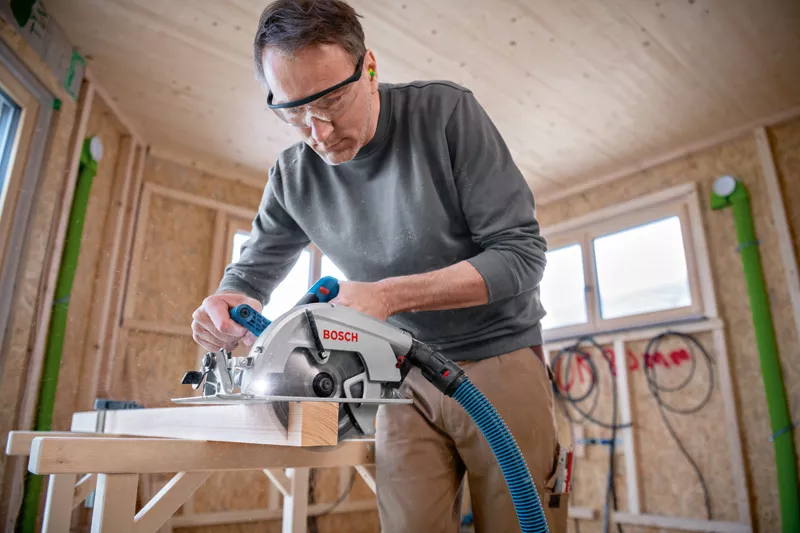A cordless skill saw, also known as a cordless circular saw, is a portable and versatile power tool that operates without being tethered to an electrical outlet. It is designed to make straight or curved cuts in various materials, such as wood, plastic, and even light metal. Unlike traditional corded saws, cordless skill saws are powered by rechargeable lithium-ion batteries, providing mobility and freedom of movement on the job site.
There are two main types of cordless skill saws: sidewinders and worm drives. Sidewinders have the motor and blade positioned in a parallel configuration, making them more compact and lightweight. Worm drives, on the other hand, feature a motor and blade arrangement at a right angle, providing increased cutting power and durability, but at the cost of added weight.
Cordless skill saws offer several advantages over their corded counterparts. Firstly, they eliminate the need for a power cord, allowing users to work in areas where access to electrical outlets is limited or non-existent. This increased mobility is particularly beneficial for construction workers, remodelers, and DIY enthusiasts who frequently need to move around the job site.
Additionally, cordless skill saws are generally lighter and more maneuverable than corded models, reducing fatigue during extended use. They also eliminate the risk of accidentally cutting through the power cord, which can be a safety hazard on busy job sites.
Table of Contents
Key Features and Components
A cordless skill saw is a versatile and powerful tool that offers several key features and components. At its core, it consists of a high-torque motor that drives a circular blade, allowing for precise and efficient cutting through various materials.
The blade is a crucial component, typically ranging from 6-1/4 to 7-1/4 inches in diameter. Blades are available in different tooth configurations and materials, such as carbide-tipped or diamond-coated, to handle specific cutting applications like wood, metal, or masonry.
Powering the motor is a rechargeable lithium-ion battery pack, which provides the cordless convenience and portability that sets these saws apart. Battery capacities vary, but higher amp-hour ratings generally translate to longer runtimes between charges.
Safety features are paramount in cordless skill saws. These may include blade guards, electric brake systems that quickly stop the blade after the trigger is released, and anti-kickback mechanisms to prevent dangerous kickbacks during cutting.
Ergonomic design is also a crucial aspect, with features like rubberized grips, balanced weight distribution, and well-positioned controls to reduce user fatigue and improve control during extended use.
Many cordless skill saws also incorporate advanced features like brushless motors for increased efficiency and longevity, LED work lights for improved visibility, and adjustable depth and bevel settings for versatile cutting operations.
Power and Runtime
Cordless skill saws are powered by rechargeable lithium-ion batteries, with voltage ratings typically ranging from 18V to 36V. Higher voltage batteries generally provide more power and runtime, but also add weight and cost. Common battery capacities are between 2Ah and 6Ah, with higher amp-hour (Ah) ratings translating to longer runtimes between charges.
Runtime can vary significantly depending on the battery capacity, voltage, and the intensity of the cutting task. Manufacturers often provide estimates, such as up to 1 hour of continuous use on a 4Ah battery. However, factors like blade type, material density, and depth of cut can impact actual runtime. More demanding cuts will drain the battery faster.
Charging times also depend on the battery capacity and the charger used. A typical 4Ah battery might take around 1 hour to fully charge with a fast charger, while larger batteries or standard chargers could take 2 hours or more. Some manufacturers offer rapid chargers that can replenish batteries in as little as 30 minutes, albeit at a higher cost.
It’s advisable to have spare batteries on hand for extended job sites or projects, as swapping depleted batteries is quicker than waiting for a recharge. Battery life can also degrade over time, so replacing aging batteries may be necessary to maintain optimal runtime.
Cutting Capacity and Performance
Cordless skill saws are designed to deliver impressive cutting power and performance, allowing you to tackle a wide range of materials with ease. One of the key factors that determine the saw’s cutting capacity is its depth of cut. Most cordless skill saws offer a depth of cut between 2-1/4 inches to 2-1/2 inches, which is sufficient for cutting through standard dimensional lumber, plywood, and other common construction materials.
In terms of material cutting capacity, these saws can handle various materials, including wood, plastic, metal, and even masonry products like concrete and bricks, depending on the blade used. The powerful brushless motors and high-torque gearing systems ensure that the saw maintains a consistent speed and power output, even under heavy load.
Speed is another crucial aspect that contributes to the saw’s performance. Cordless skill saws typically operate at speeds ranging from 3,500 to 6,000 RPM, allowing for smooth and efficient cutting through different materials. The higher the RPM, the faster and cleaner the cut, particularly when working with dense or abrasive materials.
Accuracy is also a critical factor in determining the saw’s performance. Most cordless skill saws come equipped with robust aluminum or magnesium alloy shoe plates, which provide a stable and sturdy base for precise cutting. Additionally, many models feature built-in bevel adjustments, allowing you to make angled cuts with ease, further enhancing the saw’s versatility.
Overall, the cutting capacity and performance of cordless skill saws have significantly improved in recent years, thanks to advancements in battery technology and motor design. With the right blade and proper technique, these saws can deliver clean, accurate cuts through a wide variety of materials, making them an essential tool for professionals and DIY enthusiasts alike.
Blade Types and Applications
Cordless skill saws are versatile tools capable of cutting through various materials, thanks to the wide range of available blade types. The choice of blade depends on the specific application and the material being cut.
Wood Cutting Blades: These blades are designed for cutting wood, plywood, and other wood-based materials. They typically have a high tooth count (24 to 60 teeth) and a thin kerf (blade width) for clean and precise cuts. Common materials for wood cutting blades include high-speed steel (HSS) and carbide-tipped blades.
Metal Cutting Blades: For cutting through ferrous metals like steel, cast iron, and other tough materials, metal cutting blades are essential. These blades have fewer teeth (typically 14 to 24) and a thicker kerf to withstand the rigors of cutting metal. They are often made from high-speed steel or carbide for increased durability and longevity.
Abrasive Blades: These blades are designed for cutting through masonry, concrete, brick, and other abrasive materials. They feature diamond or tungsten carbide grit edges that can grind through hard surfaces. Abrasive blades are available in different grit sizes, with coarser grits for rougher cutting and finer grits for smoother finishes.
Demolition Blades: Also known as nail-cutting blades, these are specifically designed for demolition work, cutting through nails, screws, and other embedded objects in wood or other materials. They have a thick, sturdy construction and widely spaced teeth to resist binding and kickback.
Combination Blades: As the name suggests, combination blades are versatile and can cut through a variety of materials, including wood, plastic, non-ferrous metals, and even thin sheets of ferrous metals. They typically have a medium tooth count and a kerf width that strikes a balance between clean cuts and durability.
When choosing a blade, consider the material you’ll be cutting, the desired cut quality, and the specific requirements of your project. Proper blade selection and usage are crucial for optimal performance, safety, and blade longevity.
Safety Features and Precautions
Cordless skill saws are powerful tools that require proper safety precautions to prevent injuries. One of the most important safety features is the blade guard, which covers the blade when not in use and retracts during cutting. This guard helps protect against accidental contact with the spinning blade.
Another crucial safety feature is kickback prevention. Kickback occurs when the blade binds or gets stuck in the workpiece, causing the saw to violently thrust back towards the operator. Cordless skill saws often have anti-kickback mechanisms, such as brake systems or riving knives, that help prevent or reduce the severity of kickbacks.
Safety switches are also essential. These switches require a specific sequence of actions to start the saw, preventing accidental starts. Some saws also have electric brake systems that quickly stop the blade after the trigger is released, reducing the risk of injury.
Finally, personal protective equipment (PPE) is crucial when operating a cordless skill saw. Wear safety glasses or goggles to protect your eyes from flying debris, and use ear protection to guard against the loud noise produced by the saw. Gloves can help improve grip and prevent cuts, while sturdy work boots can protect your feet from dropped tools or materials.
Brands and Models
When it comes to cordless skill saws, there are several popular brands that offer a wide range of models to choose from. Some of the most well-known and respected brands in the industry include DEWALT, Makita, Milwaukee, Bosch, and Ryobi.
DEWALT is a leading brand known for its durable and powerful tools. Their cordless skill saws, such as the DEWALT DCS391B 20V MAX Li-Ion Circular Saw, are highly regarded for their impressive cutting performance and long-lasting battery life. Makita, another top brand, offers models like the Makita XSS02Z 18V LXT Lithium-Ion Cordless Circular Saw, which is known for its compact size and efficient brushless motor.
Milwaukee is another brand that has gained a reputation for producing high-quality cordless skill saws. Their M18 FUEL 18-Volt Lithium-Ion Brushless Cordless 6-1/2 in. Circular Saw is a popular choice among professionals, offering impressive power and runtime. Bosch’s cordless skill saws, such as the Bosch GKM18V-25GCN 18V EC Brushless Cordless Lithium-Ion Circular Saw, are also highly regarded for their precision and durability.
For those on a budget, Ryobi offers affordable yet capable cordless skill saws like the Ryobi P508 One+ 18V Lithium-Ion Cordless 5-1/2 in. Circular Saw. While not as powerful as some of the premium models, Ryobi’s tools are known for their value and versatility.
When comparing cordless skill saw models, it’s important to consider factors such as battery voltage (typically 18V or 20V), blade size, cutting depth capacity, weight, and ergonomic design. Top-rated models often feature brushless motors for increased efficiency and runtime, as well as advanced safety features like electric brakes and blade guards.
Maintenance and Care
Proper maintenance and care are crucial for ensuring the longevity and optimal performance of your cordless skill saw. Regular cleaning, blade changes, battery care, and proper storage can help extend the tool’s lifespan and keep it running smoothly.
Cleaning
Keep your cordless skill saw clean and free from dust and debris buildup. Use a soft brush or compressed air to remove sawdust and other particles from the saw’s body, vents, and blade guard. Avoid using solvents or harsh chemicals, as they can damage the tool’s plastic components and seals.
Blade Changes
Dull or damaged blades can not only affect the quality of your cuts but also pose a safety hazard. Inspect the blade regularly and replace it when necessary. Follow the manufacturer’s instructions for properly installing and securing the new blade.
Battery Care
The battery is the heart of your cordless skill saw, and proper care is essential for maintaining its performance and lifespan. Avoid exposing the battery to extreme temperatures, as this can degrade its capacity over time. Fully charge the battery before storage and recharge it every three to six months to prevent complete discharge, which can damage the battery cells.
Storage
When not in use, store your cordless skill saw in a dry, secure location, away from direct sunlight and moisture. Remove the battery and blade before storing the tool, and consider applying a light coat of protective oil to the blade and other metal components to prevent rust and corrosion.
By following these maintenance and care guidelines, you can ensure that your cordless skill saw remains in top condition, ready to tackle any cutting task with precision and efficiency.
Accessories and Add-ons
Cordless skill saws offer a range of accessories and add-ons to enhance their functionality, convenience, and versatility. One of the most essential accessories is replacement blades. Manufacturers offer a variety of blade types, including those for wood, metal, masonry, and even demolition work. Having the right blade for the job ensures clean, precise cuts and optimal performance.
Another crucial accessory is extra batteries. Since cordless saws rely on battery power, having spare batteries on hand allows for uninterrupted work and extended runtime. Many manufacturers offer high-capacity batteries that can last for hours, minimizing downtime and increasing productivity.
For added convenience and portability, cordless skill saw kits often include durable carrying cases or storage bags. These cases not only protect the saw and accessories during transport but also keep everything organized and easily accessible on the job site.
To maintain a clean work environment and minimize dust exposure, many cordless saws are compatible with dust collection systems. These systems can be integrated into the saw or attached as an external accessory, capturing dust and debris as you cut, ensuring a safer and cleaner workspace.
Other useful add-ons include rip fences for straight cuts, laser guides for improved accuracy, and adjustable depth stops for precise depth control. Additionally, some manufacturers offer specialized accessories like metal-cutting abrasive discs or diamond blades for cutting through tough materials like concrete or tile.
Cordless vs. Corded Skill Saws
Choosing between a cordless and corded skill saw can be a crucial decision, as each option offers distinct advantages and limitations. The primary difference lies in the power source, with cordless saws relying on rechargeable batteries and corded saws requiring a constant connection to an electrical outlet.
Pros of Cordless Skill Saws:
- Portability and Maneuverability: Cordless skill saws provide unparalleled mobility, allowing you to work in remote or confined areas without the restriction of a power cord. This freedom of movement can significantly improve efficiency and productivity on job sites.
- Convenience: Without the need for a power cord, cordless saws eliminate the hassle of managing tangled cords, reducing trip hazards, and increasing overall safety on the worksite.
- Versatility: Cordless skill saws are ideal for a wide range of applications, from quick cuts and trim work to larger projects, making them a versatile tool for both professionals and DIYers.
Cons of Cordless Skill Saws:
- Limited Runtime: Cordless saws are powered by rechargeable batteries, which have a finite runtime before requiring recharging or replacement. This can potentially disrupt workflow and productivity, especially for prolonged or demanding tasks.
- Battery Life and Cost: Over time, the batteries in cordless saws may degrade, requiring replacement, which can add to the overall cost of ownership.
- Power Limitations: While cordless skill saws have become increasingly powerful, they may still lag behind their corded counterparts in terms of raw cutting power, especially for heavy-duty applications or dense materials.
Pros of Corded Skill Saws:
- Continuous Power: Corded skill saws have a constant supply of power from the electrical outlet, allowing for uninterrupted operation and consistent performance, even during demanding tasks.
- Higher Cutting Power: Corded saws generally offer more cutting power and torque, making them better suited for heavy-duty applications, such as cutting thick or dense materials.
- Cost-Effective: While the initial cost of a corded saw may be higher, the absence of batteries and the associated replacement costs can make them more cost-effective in the long run.
Cons of Corded Skill Saws:
- Limited Mobility: The need for a power cord restricts the mobility and reach of corded skill saws, potentially hindering productivity in certain situations or job sites.
- Trip Hazards: Power cords can create tripping hazards, especially in cluttered work environments, posing a safety risk if not managed properly.
- Cord Management: Dealing with tangled or snagged power cords can be frustrating and time-consuming, potentially disrupting workflow.
When choosing between a cordless or corded skill saw, consider factors such as the nature of your projects, the required cutting power, the importance of mobility, and your personal preferences. Cordless saws offer unparalleled convenience and portability, making them ideal for smaller tasks or job sites with limited access to power outlets. Corded saws, on the other hand, excel in demanding applications where continuous power and maximum cutting performance are essential.
Buying Guide and Tips
When shopping for a cordless skill saw, there are several factors to consider to ensure you get the right tool for your needs and budget. Here are some tips to keep in mind:
What to Look For:
- Battery Life and Runtime: Check the battery capacity (Ah) and voltage (V) to determine the tool’s runtime. Higher Ah and V ratings generally mean longer runtime between charges.
- Blade Size: Common blade sizes range from 6-1/2″ to 7-1/4″. Larger blades offer deeper cutting capacity but may compromise portability.
- Cutting Depth and Capacity: Consider the maximum cutting depth at 90° and 45° for the materials you’ll be working with.
- Motor Power: Look for saws with higher torque and RPM ratings for improved cutting performance, especially on tougher materials.
- Weight and Ergonomics: Opt for a well-balanced and comfortable design, especially if you’ll be using the saw for extended periods.
- Safety Features: Look for features like electric brakes, blade guards, and anti-kickback mechanisms for added safety.
Budget Considerations:
Cordless skill saws can range from around $100 for basic models to $300 or more for premium, high-performance options. Generally, you’ll pay more for longer runtime, higher power, and advanced features. Determine your budget and prioritize the features most important to your needs.
User Reviews:
Before making a purchase, read user reviews from various sources to get a sense of real-world performance, durability, and any potential issues. Pay attention to reviews from users with similar needs and experience levels as yours.



